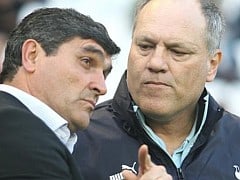You can trust VideoGamer. Our team of gaming experts spend hours testing and reviewing the latest games, to ensure you're reading the most comprehensive guide possible. Rest assured, all imagery and advice is unique and original. Check out how we test and review games here
The ups and downs of football management are like nothing else. Following an eight match unbeaten run, which saw my Spurs side rise to third in the Premier League, came a series of seven league matches without a win – my once free scoring team managed only two goals and three points and slipped to ninth. The pressure was beginning to pile up both from the board of directors and fans, injuries to top players hit the team badly and I was left wondering what to do next. The answer was simply to keep playing. Keep playing for another five hours. We were going through dark times, but nothing could keep me from micro-managing every aspect of the club.
Sports Interactive has been releasing a new edition of its hugely successful football management simulation for as long as I can remember, each year giving the legions of fans a bit more control and added realism in the day-to-day management of a football club. The big additions in this year’s edition are a new 3D match engine, an increased role for the assistant manager, improved manager interaction with the press and what Sports Interactive states is a completely rebuilt transfer system. But more on those later. First back to my time at Spurs.
I took charge in the summer of 2008 and was given £27 million to spend to strengthen the squad. It’s worth pointing out that although the game picks up before the start of the 2008/2009 season, all player transfers are up-to-date, meaning Spurs deserters Keane and Berbatov had packed their bags for Liverpool and Manchester respectively. Before I had the chance to dabble in the transfer market a press conference was called for the club to formally announce my role as manager.
Entirely text-based, the new press conference system gives players the ability to develop a stronger managerial character than in previous FM instalments. I wasn’t about to turn my back on a rich history of attacking football so confidently claimed that under my leadership Spurs would play the kind of football to make even Arsenal fans stand up and applaud. I also made it clear that I had funds available to bring in a few new faces where I felt the current squad was particularly weak. The conference over, I was told that the players had responded well to my appointment.
Press conferences soon become a regular part of your life as manager, speaking to the press before and after each match. What you say can make a real difference too, with positive comments on the match to come or praise of a good performance likely to give your players a morale boost. However, I found that once the initial thrill of seeing my name in numerous press reports wore off, I had no interest in taking part in the further press conferences. Instead I handed all such duties over to Gus Poyet, my assistant manager.
It was then time to tinker with the transfer system. I’d identified a weakness in the middle of the park and also felt the team lacked the attacking flair once offered by the Berbatov and Keane partnership. My first signing came as a result of a rumour linking the club to Sampdoria’s midfield General Angelo Palombo. The Italian hadn’t even been on my radar, but further investigation and staff feedback led me to believe he was just the player to shore up my weak midfield. Such a highly regarded player wasn’t going to come cheap though and after several rounds of negotiations I secured his services for £14 million. New signings that followed included AC Milan’s Massimo Ambrosini for £6.75 million and youth striker Robert Lewandowski for £1 million from Lech.
With the best part of £24 million spent it left me very little to play with, but that didn’t prevent me from making an offer for long-time Tottenham target Andrei Arshavin. Again, after much negotiation which saw Zenit’s asking price drop from £22 million to £12 million (rising to £16 million on appearances) I managed to strike a deal and after some sweating over a work permit the Russian was mine. Well, he would have been had I remembered to raise some cash by shipping out the dead wood. I had to delay the transfer and frantically began faxing clubs with lists of players available to buy. After several weeks I’d managed to offload Jenas, O’hara, Zokora and Huddlestone raising £16 million. Arshavin was mine and my team looked like real title contenders.
Of course there’s much more to winning than building a team that looks good on paper, something my pre-season made abundantly clear. My tactics simply weren’t working and it wasn’t until I listened to the advice offered by Gus that things began to change for the better. In FM 2009 your assistant manager has been given an expanded role. During a match you’ll get feedback highlighting areas in which your team tactics are working and the areas in which a tactical change might be required. You can choose to ignore this advice if you wish, but for new managers it’s a great way to give you a push in the right direction without taking you out of the virtual managerial world the game tries so hard to create.
Speaking of the virtual experience, the most obvious new addition to FM 2009 is the new 3D match engine. The classic 2D view is available if you wish, but there’s no doubt that the match action comes to life like never before when viewed in 3D. When watching the action play out in front of you in the TV view mode it’s also possible to access a rather nifty Widget system which makes it easy to customise the display with a host of information. This includes player ratings, assistant manager feedback, a match radar and many others. It also looks great in widescreen and the extra screen space is very welcome after years of being stuck with a 4:3 display ratio.
So, as I said, my season began to improve once my tactical naivety was put right by Gus. After a series of eight unbeaten games and nine goals from Pavlyuchenko we were sitting third in the Premier league. By this point I’d already implemented some new training schedules to get the best out of my players, but hadn’t looked at the new player Preferred Moves found in the player interaction screen. Here you can get players to focus on changing their game in a specific way, be it to aim to score in the corners of the net, opt to go round the keeper, dribble down the line or stay on their feet when tackling. I told David Bentley to try to blast the ball into the net and 15 minutes later I’d given out instructions to each of my first-team squad. Some took my recommendations better than others. While Bentley was happy to take my advice, Ambrosini outright refused to adapt his game.
I have a feeling it was my Preferred Move tinkering that led to to the end of my unbeaten run; unrest in the dressing room led to poor performances that saw the team slide to ninth in the league. The situation wasn’t helped by a derby match against Arsenal in which it seemed the Gunners had actually taken pistols onto the pitch – I was left with serious injuries to Arshavin, Palombo, Ambrosini, Bent, Bentley and Modric;. It took two months before I could field what I felt to be my strongest team and had to settle for a disappointing tenth place finish. Thankfully it was good enough to hold onto my job.
One season in and 25 hours of my life gone it’s clear that Football Manager 2009 is every bit as addictive as it’s ever been. The odd problem does remain however. As with FM 2008 I found penalty shoot outs to be completely unrealistic – on three occasions I had shoot outs that ended in double figures. The 3D match engine, although in my opinion an improvement over the 2D view, doesn’t look great even with a powerful system. The new press conference system will likely be a Marmite feature, but perhaps my biggest problem has been the regularity that players pick up injuries in matches. The aforementioned match against Arsenal proved to be the worst case, but it was rare to finish a match without a player picking up some form of problem.
However, no problem proved bad enough to significantly tarnish my experience and on the whole Sports Interactive has tweaked an already brilliant game to make something even better. If you want a high stress virtual job on top of your real one, have hours to burn each day looking at an interactive database, and fancy yourself as the next Alex Ferguson, Football Manager 2009 might be the only game you’ll need until this time next year.

/https://oimg.videogamer.com/images/79ed/fm_2009_4.jpg)
/https://oimg.videogamer.com/images/9218/fm_2009_13.jpg)
/https://oimg.videogamer.com/images/d711/fm_2009_2.jpg)
